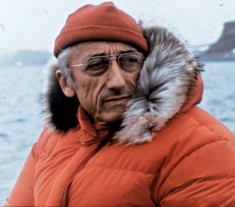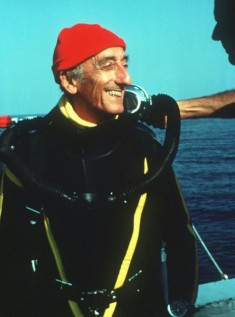Jacques Cousteau was a French explorer, naval officer, innovator, scientist, photographer, researcher and author who studied the sea and all forms of life in water. He is best known for his great works in developing the Aqua-lung. He also pioneered marine conservation and he was even a member of the Academie francaise.
Early Life
Jacques Cousteau was born on June 11, 1910, in Gironde, France. He had only one brother and completed his preparatory studies in Paris. In 1930, he joined the Ecole Navale where he graduated as a gunnery officer. However, he got into an automobile accident that cut short his career in naval aviation. After the accident, he shifted his interest towards the sea.
He served on the Condorcet in Toulon. Here he performed some underwater experiments. This was made possible after his friend Philippe Tailliez decided to lend him some Fernez underwater goggles. Since Jacques Cousteau belonged to the information service of French Navy, he was sent on different missions to Japan and Shanghai and the USSR in 1939.
On July 12, 1937, he married Simone Melchoir. Together, the couple had two sons. The two sons actually took part in the popular adventures of Calypso. In 1990, his wife died of cancer and one year later, he married Francine Triplet. The couple had two children as well.
Career in Underwater Diving
After the armistice of 1940, Cousteau’s family took refuge in Megeve. Here he became good friends with the Ichac family who lived there, too. Marcel Ichac and Jacques both shared many of the same interests. They both wanted to reveal to the public some unknown and inaccessible places. Jacques wanted to reveal the underwater world and Ichac wanted to explore the high mountains.
In 1943, the two friends won a prize of Congress of Documentary Film. This was for the first French underwater film. The film was made without a breathing apparatus. Instead, they used some deep-pressure-proof cameras developed by Leon Veche. Their film, Shipwrecks, was made in 1943. In this film, the two friends used the very first Aqua-Lung prototypes. When making this film, Cousteau could not find the necessary blank reels of movie film. He had to buy hundreds of tiny camera film reels with the same width. These were intended for making a child’s camera and so he cemented them together to form long reels.
Aqua Lung and More Exploration
During the 1940s, Cousteau is credited with improving the aqua-lung design. This design was a key element in the creation of open-circuit scuba technology that is used today. According to his book, Jacques began diving with Fernez in 1936. In 1939, he managed to use the self-contained underwater breathing tool that was invented by Yves le Prieur in 1926.
Jacques was not satisfied with the actual time period spent underwater with the Le Prieur apparatus. Therefore, he decided to improve the apparatus to prolong the underwater duration. This was made possible by adding a demand regulator. In 1943, he tried out the improved prototype aqua-lung. This apparatus made extended underwater exploration much easier.
Cousteau and GERS
In 1946, Jacques and Tailliez were given permission to set an underwater research group called GERS. In 1948, in between missions of mine clearance, technological tests, physiological tests and underwater exploration, Cousteau undertook his first campaign in the Mediterranean. Together with other people, the team undertook the exploration using some autonomous diving. This opened way for scientific underwater archaeology.
Cousteau’s Later Achievements
 In 1949, Jacques Cousteau left the French Navy. He founded the FOC (French Oceanographic Campaigns) in 1950. He also carried out underwater archaeology excavations in the Mediterranean. In 1953, he published his first book, The Silent World.
In 1949, Jacques Cousteau left the French Navy. He founded the FOC (French Oceanographic Campaigns) in 1950. He also carried out underwater archaeology excavations in the Mediterranean. In 1953, he published his first book, The Silent World.
Four years later, in 1957, he was elected director of Oceano-graphical Museum of Monaco. In 1976, he uncovered the wreck of the HMHS Britannic. He was also able to find the wreck of French 17th Century ship-of-the-line – La Therese – in the coastal waters of Crete. One year later, he received the UN International Environment prize. In 1980, he travelled to Canada to make two films about the Great Lakes and Saint Lawrence River. They were entitled Cries from the Deep and St. Lawrence: Stairway to the Sea.
Cousteau’s Death and Legacy
On June 25, 1997, Jacques Cousteau died of a heart attack while in Paris. He was age 87. He was buried in a Roman Catholic funeral despite many rumors that he might have converted to Islam.
During his lifetime, he received many awards and distinctions. His legacy includes more than 120 television documentaries, 50 books, and a foundation with over 300,000 members. His work also created a new kind of scientific communication that was at first criticized, but it is now widely accepted.
